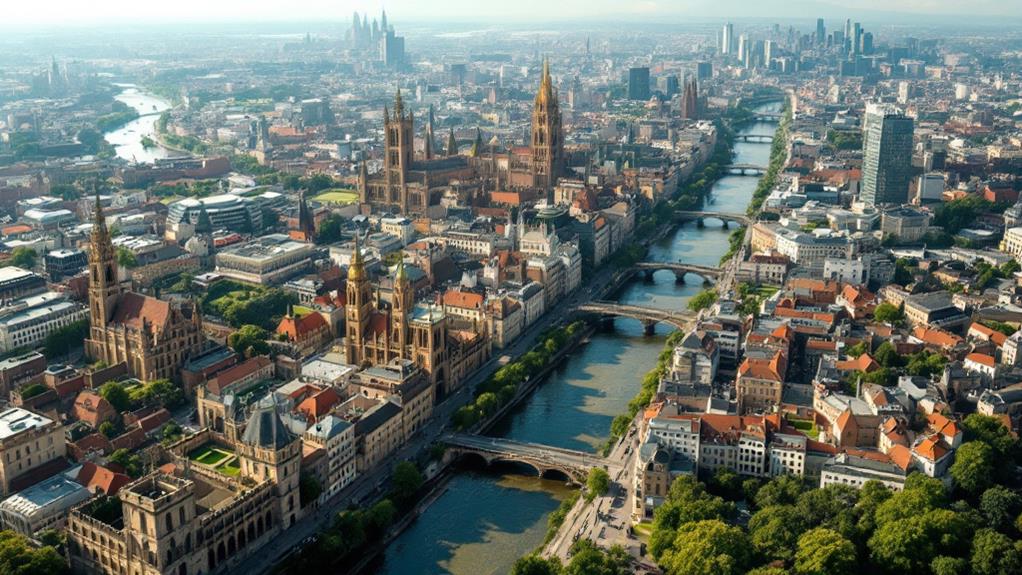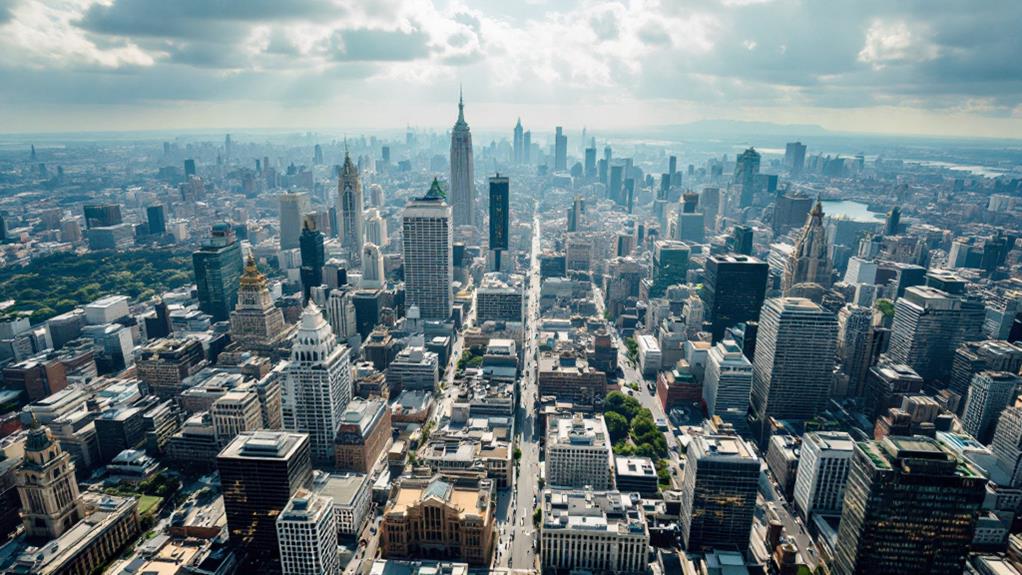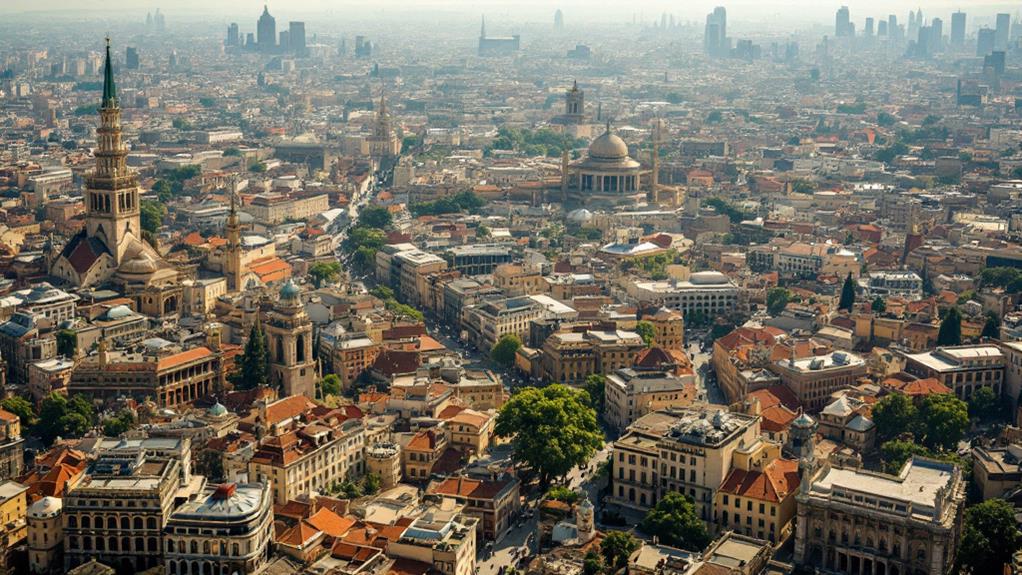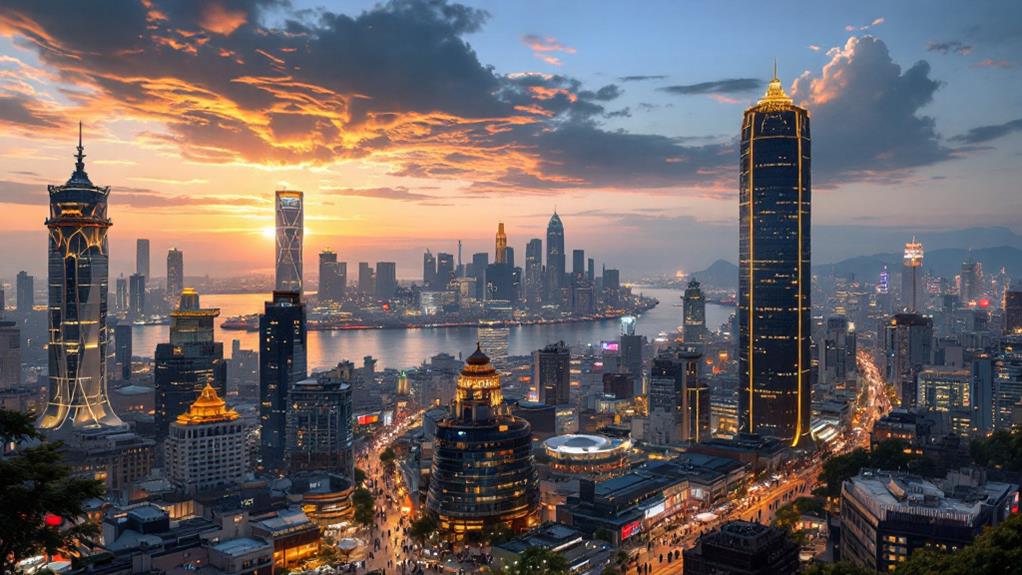Historic Growth of the Largest Cities: How Urbanization Shaped the World

Urbanization has dramatically shaped the world by transforming how you live and work. It began with early cities like Eridu and Uruk in Mesopotamia, where settled societies utilized agricultural surpluses for growth. Today, more than half of the global population resides in urban areas. The rise of megacities, like Kinshasa, highlights rapid expansion driven by job opportunities and migration. However, urbanization also brings challenges, from slum development to environmental concerns. As cities evolve, they fuel economic growth, yet pose new demands on infrastructure and planning. Exploring the historic progression of urbanization reveals more about these transformative shifts.
Origins of Urban Centers
Urban centers often trace their origins back to the dawn of civilization, with the earliest cities springing up around 7500 B.C.E. in Mesopotamia. This region, known as the Fertile Crescent, was home to major urban centers like Eridu, Uruk, and Ur. These cities thrived due to their strategic locations near the Euphrates and Tigris rivers, which facilitated trade and transportation. As you investigate these early urban centers, you'll notice how they shifted from nomadic lifestyles to permanent communities, a change driven primarily by agricultural surpluses.
These surpluses allowed populations to settle, leading to the development of complex societies. In these emerging cities, people engaged in trade, exchanging goods and ideas, which in turn, fueled economic and cultural growth. The emergence of cities marked a significant shift in human society, transforming urban areas into lively hubs of trade and cultural exchange.
Global Urbanization Trends
In recent years, the world has seen an unprecedented surge in urbanization, with over 4 billion people now living in cities as of 2023. This marks a significant shift, as more than half of the global population now resides in urban areas—a milestone initially reached in 2007. This rapid urban population growth highlights the transformative impact of urbanization across the globe.
By 2050, the United Nations projects that nearly 7 billion people—about 68% of the global population—will live in urban areas. This ongoing shift underscores the importance of understanding urbanization trends and their implications for the largest cities worldwide. Historically, urbanization rates have skyrocketed since the 19th century. In 1800, less than 10% of the global population lived in cities; today, it's over 50%, illustrating a remarkable trajectory of population growth.
However, urbanization isn't uniform across all nations. High-income countries boast over 80% urbanization, while many low-income nations remain largely rural, despite accelerating urban migration. Centralization is evident, as in some regions like Africa and Latin America, over 50% of the urban population resides in their largest cities, highlighting the concentration of economic and social activities.
Defining Urban Areas

Although defining what constitutes an urban area may seem straightforward, the criteria actually vary widely between countries, creating a patchwork of definitions. Each nation sets its own standards, often relying on population thresholds, density, and infrastructure metrics to classify urban areas. For example, in Sweden, an area must have at least 200 inhabitants to be considered urban. In contrast, Japan adds economic criteria to its population-based definitions. These varying definitions can complicate efforts to accurately measure urbanization globally.
When you rely on national census data to estimate urban populations, as the United Nations does, discrepancies inevitably arise. Because of different definitions, comparing urbanization levels between countries becomes challenging. This inconsistency in urban data can greatly impact urban planning and development strategies worldwide. Critics argue that without standardized definitions, global urban population estimates are inconsistent and unreliable.
In 2020, the UN recommended harmonizing these definitions to improve the comparability and consistency of urban data worldwide. This ongoing debate underscores the importance of clear, consistent definitions for urban areas. By aligning definitions, you can boost the accuracy of urbanization metrics, ultimately leading to better-informed policy decisions and urban planning efforts.
Growth of Megacities
Understanding the complexities of defining urban areas sets the stage for exploring the fascinating phenomenon of megacities. These vast urban areas, each housing over 10 million people, have mushroomed to 33 globally as of 2018. This remarkable growth of megacities is largely fueled by urban migration, high fertility rates, and the expansion of city boundaries. In places like Kinshasa, the population has doubled every five years since 1950, illustrating the rapid pace of urbanization. Historically, cities like New York and Tokyo were pioneers, surpassing the 10 million mark by the 1950s and highlighting early trends in urbanization.
As you examine these megacities, you'll notice that they offer numerous job opportunities, drawing people from rural areas seeking better livelihoods. However, this rapid population density increase also brings significant challenges. The strain on infrastructure, resource management, and public health issues become apparent as these cities struggle to provide adequate amenities amid overcrowding. While some regions experience unprecedented growth, historical centers like Mesopotamia have faded. Your understanding of these dynamics is essential, as the emergence of megacities continues to shape the urban landscape, posing both opportunities and challenges for the future.
Urban Population Dynamics

Cities, the lively epicenters of modern life, are experiencing a transformative change as urban population dynamics evolve. Back in 1800, less than 10% of the world's population lived in urban areas. Thanks to the Industrial Revolution, this number has surged, with projections indicating that over two-thirds will be living in urban areas by 2050. This change marks a poignant shift from rural areas to thriving urban centers, driven by the search for better employment opportunities in industries and services.
You'll notice that as people migrate from rural areas, the economic landscape changes drastically. The Industrial Revolution caused a significant decline in agricultural jobs, while urban populations soared. Today, high-income countries boast over 80% urban populations, whereas many low-income countries remain mainly rural. However, urban migration is accelerating in these regions, reshaping demographics and economies alike.
Centralization trends further highlight this change, as over 50% of the urban population in some nations resides in their largest city. This is especially true in parts of Africa and Latin America. As urban areas continue to expand, they redefine how and where people live, work, and thrive.
Slum Development Challenges
How can we tackle the persistent issue of slum development as urbanization accelerates? Nearly a quarter of the global urban population, about 1 billion people, live in slums. These areas lack adequate housing, sanitation, and infrastructure, posing significant challenges to residents' health and quality of life. In cities like Mumbai, where the population exceeds 20 million, half the residents live in such conditions, underscoring the severity of urban poverty in megacities.
Slum dwellers face severe public health challenges. They're more prone to infectious diseases and malnutrition due to poor living conditions and limited access to basic services. As urban areas expand, especially in developing countries, slums grow rapidly, highlighting the need for sustainable solutions. This aligns with the UN's Sustainable Development Goal aimed at creating inclusive and sustainable cities.
Addressing these challenges is vital for improving the comprehensive urban growth and living standards for millions. You can advocate for policies that prioritize slum upgrading, ensuring access to fundamental services like clean water and sanitation. Supporting community-driven initiatives can empower residents and transform slums into thriving urban communities, offering a better quality of life and reducing the burden on city infrastructure.
Economic Impacts of Urbanization

As urbanization progresses, it profoundly impacts economies worldwide, with cities often driving national growth. Concentrated economic activity in urban areas leads to increased productivity and wealth generation, strongly correlating with GDP per capita. When you live in a city, you typically enjoy higher living standards. Access to crucial services like electricity, sanitation, and clean drinking water is often superior compared to rural counterparts.
The labor market undergoes significant shifts due to urbanization. As populations move from rural to urban settings, there's a noticeable decline in agricultural jobs. Instead, employment opportunities in industry and services rise, altering the labor market dynamics. This shift can lead to more diverse job opportunities, but it also means traditional agricultural roles are diminishing.
Interestingly, the relationship between urbanization and economic growth isn't straightforward. Countries with a higher initial urban population don't always experience faster economic growth, suggesting a complex interplay of factors. Nevertheless, expanding urban areas become critical hubs for trade and commerce, attracting diverse populations. These cities foster innovation through cultural exchange and collaboration, becoming centers of economic and social dynamism. So, while urbanization presents challenges, its economic impacts are undeniably transformative.
Environmental and Planning Considerations
Amidst the rapid pace of urbanization, environmental and planning considerations become vital for sustainable city development. As cities grow, they contribute to about 70% of global CO2 emissions, making environmental sustainability a top priority. You need to focus on urban planning that mitigates such impacts, especially with rising population density. Cities designed for walkability and robust public transportation systems can greatly reduce car dependency, improving air quality and reducing pollution.
The emergence of megacities, particularly in Asia and Africa, requires you to develop tailored urban planning strategies. These strategies should respect local cultures, histories, and resource availability to guarantee sustainable growth. It's important to address poor urban infrastructure, which often leads to inadequate sanitation and housing. This is especially true in slums, where public health crises are more likely to occur due to overcrowding and unsanitary conditions.
Cities with a history of prioritizing environmental sustainability and community health in their planning frameworks are better equipped to handle the challenges posed by rapid growth and climate change. By focusing on thorough planning initiatives, you can improve living conditions and create more resilient urban environments.



